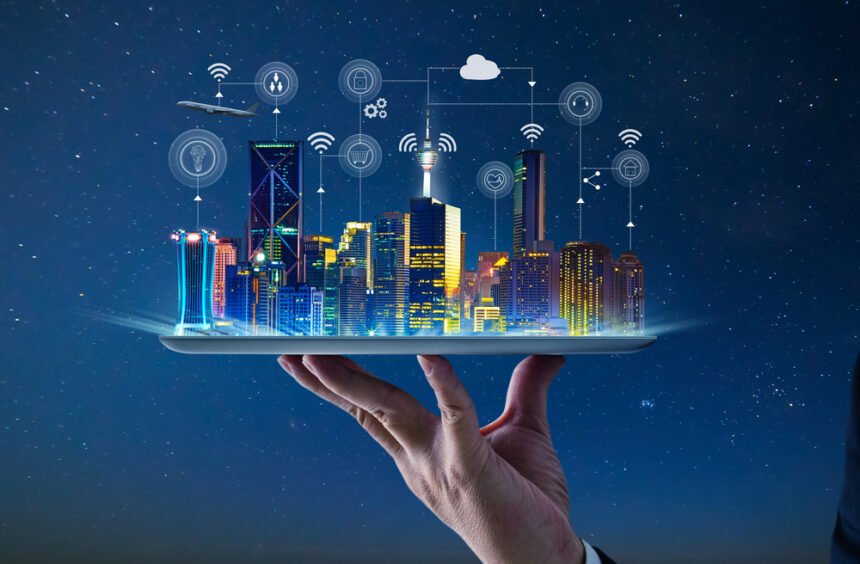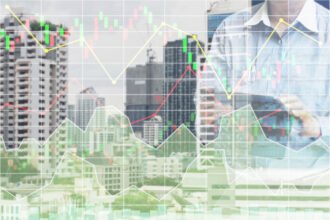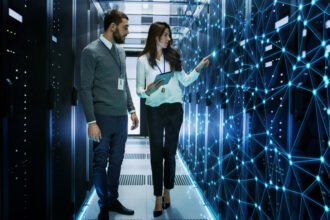It’s no secret that artificial intelligence and technology has been developing quickly in recent times, with applications such as CAPTCHA that prevent bots from accessing sites, thermostats that adapt to our daily schedules or even algorithms that could choose potential vacation destinations for us.
But what if machine learning could be used beyond niche or individual contexts? Taking artificial intelligence a step further and implementing it into our cities and infrastructures has the potential for improving operating efficiencies, aiding in sustainability efforts, urban planning and more. Below, we’ll be exploring a few of the ways that machine learning can be used for improving our cities and making them smarter overall.
Using AI to account for carbon footprints
Often times, we will hear from various forms of media that we should be aiming to reduce our individual and collective carbon footprints – however, how can cities and organizations accurately calculate their contributions to carbon emissions? Overall, a carbon footprint can be broken down into three categories – direct emissions from the organization or city’s operations (scope 1 emissions), emissions that are related to the generation of electricity required to run the city (scope 2 emissions) and emissions from consumption and production of city product (scope 3 emissions), which involve upstream suppliers and downstream consumers (e.g., city inhabitants)1.
While obtaining and processing data is a challenge, several start-up companies are developing tools that will not only quantify emissions but also help develop plans (based on data) on how to reduce emissions, such as through laying out more sustainable and informed decision making or through switching to viable renewable energy sources. Many companies use platforms like Spark 3.0 to help with data processing, but it still proves challenging.
One particular company, Watershed, hopes to be able to build a tool in which raw data can yield insight and concrete actions in which carbon emissions are reduced.
Drought Risk Assessment and Prediction
With climate change on the rise, more severe weather events such as drought are becoming more prevalent. Overall, droughts have cost the world $1.5 million between 1988-2017 and the resulting food insecurity has caused hundreds of thousands of deaths, if not more.2 Through artificial intelligence-based prediction, there can be improvement in decision making regarding droughts and better methods and timing employed to ensure optimal water resource allocation and disseminating information ahead of drought events.
One such example of AI being used for prediction of high impact weather events is the Gradient Boosted Regression Trees (GBRT) algorithm, in which it was found that in 75% of cases, AI-based forecast was chosen over human intuition by professional forecasters.2
Wildlife Conservation
There is growing evidence big data and machine learning can help save the environment. Preserving habitats for various animals is just as important within cities as it is in tropical rainforests.
Often times, conservationists and ecologists will set camera traps in order to get a better idea of what animals are living in an area, what time they are active as well and to monitor human impact on wildlife. Unfortunately, going through footage manually takes a tremendous amount of time and can delay actions that would benefit local flora and fauna. That’s where AI algorithms such as the one created by RESOLVE come in – this AI algorithm can let conservationists know about the presence of animals real time as well as identify any detected animals almost immediately so that appropriate action can be taken as soon as possible. Additionally, algorithms such as this one can be used to detect illegal activity in real time, meaning poachers will have a more difficult time capturing animals.
Air Quality Monitoring and Prediction
Air pollution unfortunately is a large issue globally. The United States alone in 2020 produced around 68 million tons of pollution4. Such pollution contributes to higher incidences of asthma and other respiratory issues, especially in vulnerable populations such as young children and the elderly. To help the general public better prepare for days of poor air quality and to put into place effective countermeasures, air quality warnings systems based off of artificial intelligence may be implemented. In particular, the AI system proposed by Mo et al., (2019) in their article ‘A Novel Air Quality Early-Warning System Based on Artificial Intelligence’ is based on an air pollution prediction model as well as an air quality evaluation model.5 Its through this system in which an early-warning system can be implemented in regards to air quality and in which data can be analyzed and used to create reasonable countermeasures in addition to predictions of air quality in the future.
AI based Parking Monitoring.
One problem common to many cities is parking. If you’ve ever been frustrated from circling around in a packed parking lot looking for a spot, this particular application of artificial intelligence will probably be of interest to you. Artificial intelligence can help through using monitors and sensors to assess real time occupancy in parking garages – if there happens to be no vacancy, then visitors will be alerted so they won’t have to waste time circling the lot.6 Additionally, AI algorithms in particularly large parking spaces can be used to guide visitors to areas of vacancy, also saving time.
Smart parking systems can also be used to gauge times of high activity based on parking occupancy so businesses can better prepare for peak hours as well as times of low parking occupation and thus low customer turnout.
Optimization of Electric Vehicle Charging
As public transport vehicles move from being powered by traditional fossil fuels to being electrically fueled, there are quite a number of things that need to be taken into consideration, such as battery storage, electric generator backup and creating or adapting a charging system for these vehicles. Additionally, there are several variables that go into the amount and cost of energy that a vehicle uses, such as weather and traffic conditions, in house vs on the go charging and peak demand constraints just to name a few.7 If cities were to adopt an AI-enabled energy optimization system, expenses could be kept to a minimum through calculating the amount of energy sources and facilities required upfront as well as integration of renewable power sources to charge the vehicles as appropriate.
Additionally, artificial intelligence integration could also help extend battery life of electric vehicles through accounting for manufacturer-based constraints and real time conditions at the same time to optimize charge level as well as minimize degradation levels.7 One way of doing so would be AI algorithms alerting the public transit company of lower than usual electricity prices but also the amount that the vehicles should be charged such that none of the batteries are overcharged.
Improving Power Grid Performance
Depending on where you live in the world, you may already be familiar with smart grids. A smart grid refers to a modern electricity system in which there are sensors, automation, communication, and computers to improve the efficiency, reliability, and safety of an electricity system. Smart grid systems can benefit a city in numerous ways including8:
- Automatic re-routing when there are abnormalities in the system.
- More integration of renewable energy systems and customer-owned power generation systems
- More efficiency electricity transmission
- Reduced operation and management costs for utilities.
- Reduced peak demand rates.
- Improved grid security
Faster restoration of power after power disturbances (which is critical in severe weather events like snowstorms or heatwaves.)
Public Safety
When it’s impossible for human eyes to keep track of all the security feeds within a city, artificial intelligence can assist – for example, microphone input from street cameras can be interpreted by AI as gun shots or other sounds indicative of distress. In such situations, AI algorithms can alert emergency service operators with location data and any other required data to decide to dispatch emergency services or not. Digital signage can be updated real time to alert the public of situations requiring attention such as flooding or other emergent situations. Another way in which AI can be used to improve upon public safety is through the controlling of traffic lights in order to clear the way for first responders rather than rely on police forces to arrive.
References
[1] R. Toews, These Are The Startups Applying AI To Tackle Climate Change (2021), Forbes.
[2] C. Huntingford, E. S. Jeffers, M. B. Bonsall, H. M. Christensen, T. Lees, H. Yang, Machine learning and artificial intelligence to aid climate change research and preparedness (2019), IOPScience.
[3] Smart Parks, Artificial Intelligence in Wildlife Conservation (2019).
[4] United States Environmental Protection Agency, Air Quality – National Summary (2021).
[5] X. Mo, L. Zhang, H. Li, Z. Qu, A Novel Air Quality Early-Warning System Based on Artificial Intelligence (2019), International Journal of Environmental Research and Public Health.
[6] N. Joshi, AI-based parking systems can address parking woes. Here’s how. Allerin.
[7] Sustainable Bus, Artificial intelligence as a mean to optimize vehicles’ charging. An interview with BluWave-ai (2020).
[8] SmartGrid.Gov, The Smart Grid (2021).











